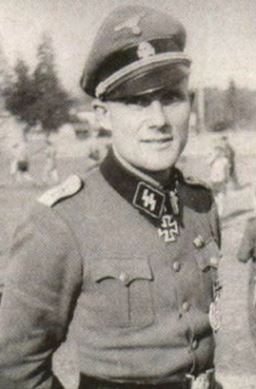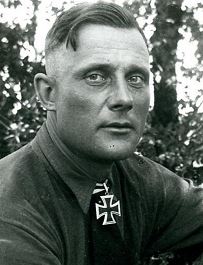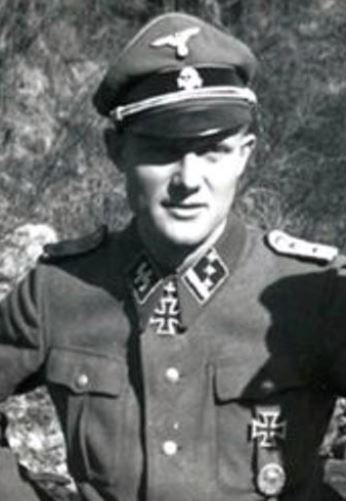Röhder, Dr.phil. Wolfgang (Waffen SS)
- Date of birth:
- August 17th, 1911 (Wuppertal-Elberfeld, Germany)
- Date of death:
- May 16th, 1945 (Prague, Czechoslovakia)
- Service number:
- SS-Nr.: 281.654 // NSDAP-Nr.:
- Nationality:
- German
Biography
Dr. Wolfgang Röhder / Roehder
00.00.1939: entered the SS-VT
00.00.1940: SS-Junkerschule Bad Tölz
31.01.1941: promoted to Untersturmführer der Reserve
00.07.1942: SS-Ustuf d.R., Zugführer, I. Zug, 2. Kompanie, I. Bataillon, SS-Regiment „Deutschland", SS-Division „Reich" (mot.)
00.02.1943: SS-Ostuf d.R., Chef, 2. Batterie, SS-Sturmgeschütz-Abteilung 2, 2. SS-Panzergrenadier-Division „Das Reich"
00.09.1943: SS-Ostuf d.R., Chef, 3. Batterie, SS-Sturmgeschütz-Abteilung 2, 2. SS-Panzergrenadier-Division „Das Reich" - fightings near Poltawa, Worskla
30.01.1944: promoted to SS-Hauptsturmführer der Reserve - RDA 22.11.1943
01.06.1944: SS-Hstuf d.R., Führer, SS-Sturmgeschütz-Abteilung 2, 2. SS-Panzergrenadier-Division „Das Reich"
06.07.1944: WIA in Normandy and evacuated
02.08.1944: SS-Hstuf d.R., Führer, SS-Sturmgeschütz-Abteilung 2, 2. SS-Panzergrenadier-Division „Das Reich"
11.09.1944: WIA - lost an eye and evacuated to a Lazarett
30.01.1945: promoted to SS-Sturmbannführer der Reserve
00.02.1945: SS-Hauptamt, Prag
16.05.1945: reported MIA in Prag
04.12.1945: some sources indicate died in Soviet captivity
Tank ace credted with more than 23 tank kills
Do you have more information about this person? Inform us!
- Period:
- Second World War (1939-1945)
- Period:
- Second World War (1939-1945)
- Period:
- Second World War (1939-1945)
- Period:
- Second World War (1939-1945)
- Period:
- Second World War (1939-1945)
- Rank:
- SS-Obersturmführer der Reserve (1st Lieutenant of Reserves)
- Unit:
- Chef, 3. Batterie, SS-Sturmgeschütz-Abteilung 2, 2. SS-Panzergrenadier-Division 'Das Reich'
- Awarded on:
- December 1st, 1943
“On the 20.09.1943 the 3. Batterie had the order to secure an important bridge across the Worskla River near Poltawa until it could be destroyed. SS-Obersturrnführer Roehder positioned one Platoon of three vehicles 800m southeast of the bridge with another 1000m northeast at a narrow passage between the railway embankment and the river. At 14:00 hours, orders were issued to destroy the bridge and friendly units, among them tanks, went back across the bridge.
At about 17:00 hours the Commander of the rearguard, SS-Obersturmbannführer Sylvester Stadler (of the Regiment "Der Führer"), came from the southeast to the bridge and instructed the Platoon covering the bridge in that direction that their mission was completed and they could cross back. At the same time the Pioneer Battalion informed Dr. Roehder that the bridge would at last be destroyed at 18:00 hours. After that Roehder ordered the other Platoon across the bridge. After both vehicles had thrown off their camouflage and were about to turn back, one was hit by an anti-tank shot fired from a close position that had gone unnoticed. With the second vehicle in a similar unfavourable position, it moved around the bend of the road and crossed the bridge together with a Panther, which was covering the area. The Platoon Leader reported the situation to Roehder, who set out across the bridge on a motorcycle to check out the situation in the direction of the knocked out assault gun. At a distance of 700m from the bridge, fire erupted from the gardens and side roads.
SS-Obersturmführer Roehder and his companion jumped from their motorcycle into a ditch and fought their way back, fighting off squads of Russian infantry with their pistols. At the next bend they managed to remount their motorcycle and set back to the bridge. The Russians pursued at great speed, obviously in order to gain control of the bridge and keep it for use as a planned attack route later. Roehder decided to defend the bridge with two men there, while the dispatch rider was sent to retrieve the Batterie, which had moved on. He ordered a 3.7cm anti-aircraft gun positioned on the opposite bank 30m from the bridge to support the almost hopeless defense of these three men. The Russians had superior numbers with houses for protection. They attacked violently from the northeast toward the bridge and soon were in front of them, firing at a distance of 70m.
Suddenly, SS-Hauptsturmführer Fleischer, who commanded a Pioneer Kompanie, came from the direction of the town across the bridge and told Roehder to hold until he could get four demolition parties. The Russians, reinforced with mortars and machine-guns, were making the situation untenable as Roehder and his men were running out of ammunition. At that moment the Batterie arrived and Roehder ordered them in a semi-circle around the bridge on the eastern bank. With concentrated fire they neutralised the Russians in all directions. After fifteen minutes Fleischer returned with the four demolition crews and Roehder covered them while they set their charges, after which he withdrew the Batterie across the bridge. As soon as the last vehicle crossed, the bridge was blown with the Russians just a few metres from it when the explosion came.
These deeds saved the Korps sector from considerable harassment, what with so many of the enemy concentrated at one bridge. Roehder's decision to defend the bridge, risking his own life, was a display of outstanding courage in a fight partly with pistols alone. It allowed the systematical withdrawal from Poltawa two days later, where all objects of value were destroyed. He also prevented our being pursued by a considerable Russian force.
SS-Obersturmführer Roehder has, with his Batterie, been at the forefront of the fighting in all of the summer battles with the Division. He led his Batterie decisively in all of the critical moments. This was especially true at Kalinin on the 8. and 14.07., at Stepanowka on the Mius on the 31.07. and at Kommunar, southwest of Kharkov on the 26.08.1943. Through his example of courage, his Batterie was always ready and he led it to great achievements. Since the 05.07.1943 his Batterie has shot up 154 enemy tanks; he himself destroyed 23 of these."
- Period:
- Second World War (1939-1945)
- Period:
- Second World War (1939-1945)
- Period:
- Second World War (1939-1945)
- Rank:
- SS-Hauptsturmführer der Reserve (Captain of Reserves)
- Unit:
- Führer, SS-Sturmgeschütz-Abteilung 2, 2. SS-SS-Panzergrenadier-Division „Das Reich“
- Awarded on:
- August 17th, 1944
- Period:
- Second World War (1939-1945)
- Period:
- Second World War (1939-1945)
Sources
- Photo 1:
- Photo 2:
- Photo 3:
- - MOONEY, PETER, Waffen-SS Knights and their Battles, Schiffer Publishing, Ltd., 2012.














